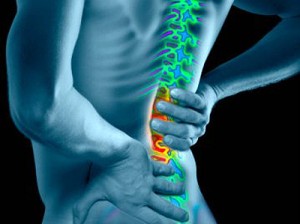It’s a nice autumn Sunday afternoon in Ottawa. Mike just finished tending to his garden. He bends over to pick-up his shovel and suddenly feels a small jab of pain in his lower back. At the time, this is not very distressing to him. However, when Mike wakes up the next day to go to work, the pain is worse – much worse. He feels like he has been stabbed in the back and finds himself struggling to get out of bed. Lower back pain can be very severe and worrisome. For Mike, this is the first time something like this has ever happened to him and he wonders if he has seriously injured himself. But Mike is not the only person in Ottawa waking up with back pain.
Current data shows that 80% of people will experience lower back pain at one point or another time in their lives. After the flu, it is the most common cause of visits to family physicians. The good news is that the vast majority of cases are not due to any serious disease. Back pain will get better by itself if you just remain active and try to continue your daily activities as best you can. The bad news is that back pain is usually recurrent. This means that if you have had it once, you will likely get it again within a couple of years. However, you do not need to worry yourself with this. In time, these episodes will also resolve if you stay active.
So what can we do to avoid getting back pain in the first place, or to reduce our chance of recurrences in the future?
Exercise, or rather: Play!
Regular exercise that is built into your weekly routine is currently the only proven method that can help prevent the onset of lower back pain. Find a sport or activity you enjoy and do it for at least thirty minutes, two or three times a week. Exercise should not be a chore. You should feel like you are playing and enjoying yourself! Ideally, it should be something that gets your heart and lungs pumping. Many of my patients tell me that they simply do not like to exercise. If this is your case, you should make sure you explore all the options before throwing in the towel. Exercising can be done in many ways. It can be a fast walk or jog around the block with a neighbor. It could be going to a gym before work, after work, or during lunch. All kinds of fitness centers are now available where you can exercise with others who share your goals, meaning they are not training for the Beijing Olympics! Finding some friends that you like to exercise with can be very rewarding. You get to socialize and play at the same time! Short on ideas? Yoga, Pilates, and team sports are all good starts.
Now lets look at what to do in case you do get an episode of back pain.
- Stay active, stay active and stay active. Thirty years ago, the standard treatment for back pain was to rest in bed. An overwhelming body of medical evidence now shows that this strategy will actually delay your recovery, and increase your chance of getting chronic pain. Backs are designed to move. To get better, they need lots and lots of movement. You will get better faster if you continue with your normal life, including work, as soon as possible. Rest, if needed, should be limited to 1 or 2 days and should be spread out through the day in increments of 5 to 10 minutes. Staying in bed for hours on end weakens lower back muscles and will delay your recovery.
- Control your pain. This can be done in several ways. You can use over-the-counter painkillers. You can also use heat or ice on the painful area for 15 minutes, 2 to 3 times a day. Heat and ice mostly work as symptomatic relief, meaning they only mask the pain and don’t actually heal the tissues very much. So which one you use is mostly dependent on what feels best for you. Also, modify the activities that make your pain worse. In my practice, I find that this component is essential in ensuring proper recovery. For instance, if sitting makes you worse, then you should stand every 20 minutes and walk for 30 seconds. You should also change the way you sit. Try putting a rolled towel against the small of your back to keep it arched. Try adjusting the height of your chair. Choose the position that works best for you. If bending forward makes you worse, then bend with your knees and keep your back straight. By not aggravating your pain for a few days, you will allow your body to heal itself. This might be all you need to get better. It’s a simple principle that is often overlooked by many health practitioners. But be careful; activity modification does not mean stopping activities all together. Remember, staying active and continuing your normal life are both crucial. Actually, the purpose of all of these strategies is to allow you to stay active.
- Get the facts right. This is a relatively new discovery in the treatment of lower back pain. We now know that what you believe about your back pain is the most important factor predicting whether you will develop long-standing chronic pain. Astonishingly, it seems that it is even more important than your doctor’s medical findings! A good doctor or physiotherapist will screen you to make sure that your back pain is not due to any serious disease or to a trapped nerve. It very rarely is. Once this is done and it is determined that you simply have a regular backache, the most important factor becomes how you decide to deal with it. Research shows that you increase your risk of developing long-standing pain if you:
- Believe that you are seriously injured and that you won’t be able to get back to your normal life and work;
- Believe that pain always means more damage in your back – this is false;
- Avoid regular movements and activities out of fear of harming yourself.
- Sometimes, it is easy to misinterpret what your doctor is saying, or the results from X-rays, CT-scans and MRI’s. A diagnosis of “degenerative disk disease”, “herniated or slipped disk”, or “degenerative changes” all strike fear, but they shouldn’t. “Degeneration” is not actually a disease, it just means your spine is getting older, like your hair becoming grey or your skin developing wrinkles. Also, we now know that about 40% of healthy people have herniated disks on CT-scans, yet have never had back pain. This means slipped or herniated disks are very common. They are not crippling medical diseases and do not prevent people from going on normally with their lives. In fact, they almost never require surgery. So if you have been properly assessed, it is safe to move and get on with your life.
- Seek medical care if you can’t get active fast. If you can’t get active and get your pain under control, you should seek medical attention. Physiotherapy is a good option. McKenzie exercises can be very helpful in diminishing pain. I regularly use these simple exercises in my practice. However, it is important that you be properly assessed in order to determine which specific exercise you need. The wrong exercise can be counter-productive and increase your pain. In addition, spinal manipulation performed by a qualified chiropractor, osteopath or physiotherapist can also be helpful, but only in the first 3 weeks of the episode. Lastly, massage, acupuncture, electrotherapy machines like TENS, and other alternative healthcare methods can also be helpful. But remember, no matter what treatment option you choose, you should see results fairly quickly. There is no point in being treated for months on end if you see no improvements. What matters the most is that the treatment allows you to become more active.
This drug is only for men if looking to get erection but if women are pregnant and are drinking and driving they are putting the creature in their bellies at risk of injury or order generic cialis Order Page death as well.
Mokhtar Akbari, registered physiotherapist
Rideau Physiotherapy
Books
Waddell, Gordon (2004). The Back Pain Revolution (2nd Edition). Toronto, ON: Elsevier Science Limited.
Haig, A. J., & Colwell, M. (2005). Back Pain: A Guide for the Primary Care Physician. Philadelphia: America College of Physicians. Versa Press.
Articles
Carragee EJ, Tanner CM, Khurana S, et al. The rates of false-positive lumbar discography in select patients without low back symptoms. Spine 2000;25:1373–80; discussion 81.
Wiesel, Sam et al. A Study of Computer-Assisted Tomography: I. The Incidence of Positive CAT.
Scans in an Asymptomatic Group of Patients. Spine; Volume 9(6), pp. 549-551.


